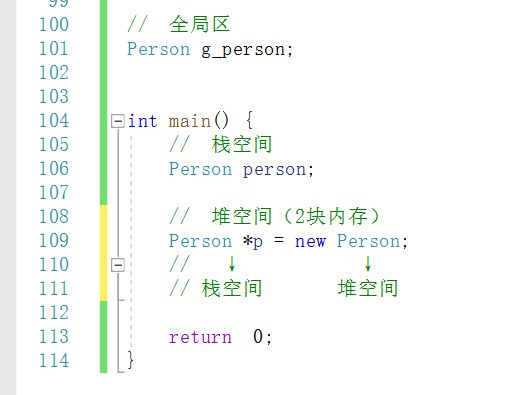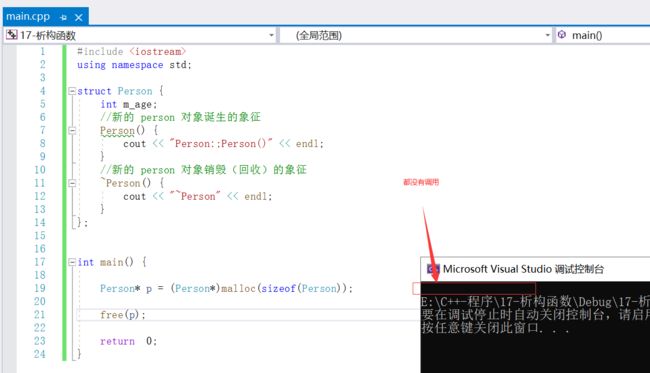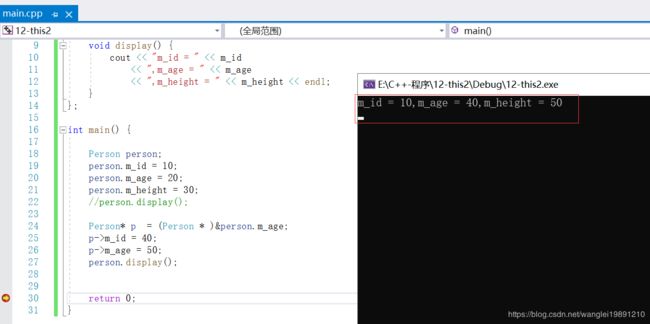C++挖掘程序本质(第二章C++面向对象-上)李明杰-M了个J 配套教材
目录
- 1.类
- 1.1 C++中可以使用struct、class来定义一个类
- 1.1.1 struct 和 class的区别
- 1.1.2 内存的栈空间,自动分配和回收
- 1.1.3 class与struct的反汇编比较
- 1.1.4 创建的对象内存情况
- 1.1.5 函数内存布局:成员函数,不占用创建对象的内存
- 1.1.6 成员变量内存布局:类中的成员变量,以创建对象的成员变量多少开辟内存
- 1.1.7 C++编程规范
- 2. 对象
- 1.1 对象的内存布局
- 1.1.1 类中多个成员变量的内存布局
- 1.1.2 内存中(4个区域)的栈空间
- 3. this
- 3.1 this 就是指向当前对象的指针
- 3.2 对象在调用成员函数的时候,会自动传入当前对象的内存地址
- 3.3 可以利用 this.m_age 来访问成员变量么?
- 3.4 指针访问对象成员的本质
- 3.5 类中多成员变量的内存分配
- 3.6 如何利用指针间接访问所指向对象的成员变量?
- 3.6.1 从指针中取出对象的地址
- 3.6.2 利用 对象的地址+成员变量的偏移量计算出成员变量地址
- 3.6.3 根据成员变量的地址访问成员变量的存储空间
- 3.7 一道题检测指针与内存
- 3.7.1 请问person.display();打印结果是?
- 3.7.3 偏移量
- 3.7.4 如果 p->display(); 结果和 person.display();又有什么区别呢?
- 3.7.5 cc -> int3 指令
- 4. 封装
- 4.1 封装就是:成员变量私有化
- 5. 内存空间的布局
- 5.1 代码段(代码区)
- 5.2 数据段(全局区)
- 5.3 栈空间
- 5.4 堆空间
- 5.4.1 使用场景
- 5.4.2 需要主动去申请和释放
- 5.4.3 x86环境(32bit)剖析 malloc
- 1)malloc
- 5.4.4 new \ delete
- 5.4.5 memset 较大数据处理函数
- 5.4.6 堆空间的初始化
- 5.4.7 结论
- 6. 对象的内存
- 6.1 对象的内存可以存放在3个地方
- 6.1.1 全局区(数据段):全局变量
- 6.1.2 栈空间:函数里面的局部变量
- 6.1.3 堆空间:动态申请内存(malloc、new等)
- 7. 构造函数(Constructor)
- 7.1 引入构造函数的使用场景
- 7.2 特点
- 7.2.1 函数名与类同名,无返回值(void不能写),可以有参数,可以重载,可以有多个构造函数
- 7.2.2 一旦自定义了构造函数,必须用其中一个自定义的构造函数来初始化对象
- 7.3 通过malloc分配的对象不会调用构造函数
- 7.3.1 不要用malloc搞对象(要去new)
- 7.4 构造函数的谬论
- 7.4.1 一个广为流传的、很多教程、书籍都推崇的错误结论
- 7.4.2 谬论的正确理解
- 7.5 构造函数的调用
- 7.5.1 全局区、栈空间、堆空间 创建对象时构造函数的调用
- 8. 成员变量的初始化
- 8.1 全局区、栈空间、堆空间,无构造函数时 初始化成员变量区别
- 8.1.1 全局区:成员变量初始化为0(int类型)
- 8.1.2 栈空间:没有初始化成员变量
- 8.1.3 堆空间
- 8.2 全局区、栈空间、堆空间,有构造函数时 初始化成员变量区别
- 8.2.1 全局区:成员变量初始化为0(int类型)
- 8.2.2 栈空间:没有初始化成员变量
- 8.2.3 堆空间
- 8.3 结论
- 9. 析构函数(Destructor)
- 9.1 引入析构函数的使用场景
- 9.2 特点
- 9.2.1 函数与析构函数
- 9.2.2 指针与析构函数
- 9.3 malloc 与 free 无关 构造函数与析构函数
- 9.4 全局区与析构函数
- 9.4 构造与析构函数必须为public
1.类
1.1 C++中可以使用struct、class来定义一个类
1.1.1 struct 和 class的区别
1)struct 的默认成员权限是 public
2)class 的默认权限是 private (实际开发中使用class)

使用class创建一个类
#include 使用struct 创建一个类
#include 1.1.2 内存的栈空间,自动分配和回收
下面的person对象和p指针的内存都是在函数的栈空间,自动分配和回收
#include person对象和p指针一共占用12个字节(4字节person+8字节*p)

1.1.3 class与struct的反汇编比较
class 编译的反汇编,如下
mov dword ptr [ebp-0Ch],14h
15: Person person;
16: person.age = 20;
01202672 mov dword ptr [ebp-0Ch],14h
struct 编译的反汇编,如下
mov dword ptr [ebp-0Ch],14h
15: Person person;
16: person.age = 20;
01202672 mov dword ptr [ebp-0Ch],14h
结论:可见class 和 struct反汇编是一致的,也就是说除了 1.1.1的性质区别,class 和 struct本质上是没区别的
1.1.4 创建的对象内存情况
#include 
上面代码的反汇编:
1)每一个 car 对象都在栈空间开辟了4个字节的存储空间
2)可以看出所有的run() 都都被编译成:call 函数地址 ,
3)3个 run() 方法都是call一样的地址,可以看出编译后的run() 方法不与对象产生在同一块内存
1.1.5 函数内存布局:成员函数,不占用创建对象的内存
成员函数(类中的函数) 在创建对象时不会被塞入对象总内存中,而是被编译后单独在内存中(如果不被调用的函数,在编译优化后将不会有内存存储此函数),即创建100个对象,只会有一份函数的内存
调用 成员函数(类中的函数)反汇编为:call 这个函数地址
成员函数(类中的函数)存储的内存与对象存储内存不同
1.1.6 成员变量内存布局:类中的成员变量,以创建对象的成员变量多少开辟内存
类中的成员变量 ,在创建对象时会在内存中开辟成员变量对应类型大小的连续内存(暂不考虑:内存对齐),如int在64位系统占用4个字节,对象的地址量即类中按顺序第一成员变量的地址

下面的对象 car1~car3总计占用 12个字节

1.1.7 C++编程规范
变量名规范参考
| 使用场景 | 方式 | 实例 |
|---|---|---|
| 全局变量 | g_ | g_count |
| 成员变量 | m_ | m_count |
| 静态变量 | s_ | s_count |
| 常量 | c_ | c_count |
2. 对象
1.1 对象的内存布局
1.1.1 类中多个成员变量的内存布局
类中成员变量在内存中是连续的存储
#include 输出:12
一个 int 占用4个字节(x64、x86相同)
1.1.2 内存中(4个区域)的栈空间
创建类的实例 date(对象)存储在栈空间,且由类内成员变量多少决定
#include 

3. this
3.1 this 就是指向当前对象的指针

3.2 对象在调用成员函数的时候,会自动传入当前对象的内存地址
可以看到编译器已经帮我们优化好了,将*person指针 演化成this 再到默认为this

3.3 可以利用 this.m_age 来访问成员变量么?
不可以,因为 this 是指针,必须用this->m_age 来访问
1). 点的左边只能是对象
2)-> 箭头的左边只能是指针
3.4 指针访问对象成员的本质

由上图可以看出 ebp-0Ch 为person1对象的地址值
注意这里2个概念地址值 如:ebp-0Ch 和 地址的存储空间 如:ecx、eax 、[ebp-0Ch]
// ebp-8 是 this指针 的地址
mov dword ptr [ebp-8],ecx 就是将person1对象的地址值存入this地址的存储空间
mov eax,dword ptr [ebp-8] 就是将this地址的存储空间(person1对象的地址值)存入eax
mov dword ptr [eax],3 就是将3赋值给this实际就是person对象地址的存储空间
========================== 汇编代码 ==============================
00A51FA0 mov dword ptr [ebp-8],ecx
19: this->m_age = 3;
00A51FAD mov eax,dword ptr [ebp-8]
00A51FB0 mov dword ptr [eax],3
这里比较绕,大家一定要把代码和反汇编,结合文中的描述一起理解
3.5 类中多成员变量的内存分配
#include 上面代码对应的汇编
========================== 对象访问 ==============================
18: Person person;
19: person.m_id = 10;
009B26D2 mov dword ptr [ebp-14h],0Ah
20: person.m_age = 20;
009B26D9 mov dword ptr [ebp-10h],14h
21: person.m_height = 30;
009B26E0 mov dword ptr [ebp-0Ch],1Eh
22: person.display();
009B26E7 lea ecx,[ebp-14h]
009B26EA call 009B104B
========================== 指针访问 ==============================
24: Person* p = &person;
009B26EF lea eax,[ebp-14h]
009B26F2 mov dword ptr [ebp-20h],eax
25: p->m_id = 10;
009B26F5 mov eax,dword ptr [ebp-20h]
009B26F8 mov dword ptr [eax],0Ah
26: p->m_age = 20;
009B26FE mov eax,dword ptr [ebp-20h]
009B2701 mov dword ptr [eax+4],14h
27: p->m_height = 30;
009B2708 mov eax,dword ptr [ebp-20h]
009B270B mov dword ptr [eax+8],1Eh
28: p->display();
009B2712 mov ecx,dword ptr [ebp-20h]
009B2715 call 009B104B
可以看出多成员变量在对象调用中:
1)对象的地址,就是类下第一成员变量的首地址 即如下:ebp-14h
2)多个成员变量在内存中是连续分配的(根据代码区的类下成员代码顺序,且当前为小端模式)

还是要明白2个概念:存储空间 和 地址值(上文提到)
将 ebp-14h 地址值存入eax的存储空间,ebp-14h就是&person
009B26EF lea eax,[ebp-14h]
将eax的存储空间 赋值给 ebp-20h地址指向的存储空间,ebp-20h是p的地址
009B26F2 mov dword ptr [ebp-20h],eax
上面2句就是Person* p = &person;
======= 分割========================================
25: p->m_id = 10;
p指针 存储空间 赋值 eax,eax 存储的就是 person对象的地址值(也是person.m_age的地址值)
009B26F5 mov eax,dword ptr [ebp-20h]
person.m_age =10
009B26F8 mov dword ptr [eax],0Ah
====== 分割========================================
26: p->m_age = 20;
009B26FE mov eax,dword ptr [ebp-20h]
009B2701 mov dword ptr [eax+4],14h
27: p->m_height = 30;
009B2708 mov eax,dword ptr [ebp-20h]
009B270B mov dword ptr [eax+8],1Eh
28: p->display();
009B2712 mov ecx,dword ptr [ebp-20h]
009B2715 call 009B104B
3.6 如何利用指针间接访问所指向对象的成员变量?
3.6.1 从指针中取出对象的地址
看到如下的汇编代码,一定是指针间接访问成员变量
mov eax,dword ptr [ebp-20h]
mov dword ptr [eax],14h
[ [ebp-20h] ]将值作为地址,取其存储空间
3.6.2 利用 对象的地址+成员变量的偏移量计算出成员变量地址
3.6.3 根据成员变量的地址访问成员变量的存储空间
3.7 一道题检测指针与内存
3.7.1 请问person.display();打印结果是?
#include 思路2次偏移量寻找
1)第一次查看当前,成员变量的偏移量
p->m_id = 40;
汇编:mov eax,dword ptr [p]
mov dowrd ptr [eax+0],40 // m_id 相对于person地址偏移量为0
p->m_age = 50;
汇编:mov dword ptr [eax+4],50 // m_age 相对于person地址偏移量为 4
2)第二次查看当前,p指针的偏移量
Person* p = (Person * )&person.m_age;
// &person.m_age 当前p指向的是&person.m_age,也就是 &person +4的偏移
3)重新整理
p->m_id = 40;
汇编:mov eax,dword ptr [p]
mov dowrd ptr [eax+0],40
mov dowrd ptr [&person+4+0],40 // 等价于 person.m_age =40
p->m_age = 50;
汇编:mov dword ptr [eax+4],50
mov dowrd ptr [&person+4+4],50 // 等价于 person.m_height =50
3.7.3 偏移量
这里所指的偏移量,全部是以类下的成员变量书写顺序,也就是类的机器码存放在代码区的顺序
class Person {
public:
int age; // 顺序开始
int height;
...
int phone;// 顺序结束
};
3.7.4 如果 p->display(); 结果和 person.display();又有什么区别呢?
// person 调用 display() 函数 传入的为&person
// 即:display(&person) &person传给this
person.display();
// p 调用 display() 函数 传入的为&person.m_age,因为age为&person偏移4个字节
// 即:display(&person+4) &person+4传给this
p->display();
m_height = -858993460 这个结果是 cc
3.7.5 cc -> int3 指令
0xccccccc
cc->int3:起到断点的作用 (interrupt 中断)

4. 封装
4.1 封装就是:成员变量私有化
提供公共的getter和setter给外界去访问成员变量
#include 输出结果:4
5. 内存空间的布局
每个内存都应有自己独立的内存空间,其内存空间一般都有以下几大区域
(下图有误“其中一个 “栈空间” 为 “堆空间”)

5.1 代码段(代码区)
用于存放代码(机器码),只读
5.2 数据段(全局区)
用于存放全局变量等(static)
整个程序运行中都存在,除非关闭进程
#include g_age 就是全局变量
5.3 栈空间
每调用一个函数就会给它分配一段连续的栈空间,等函数调用完毕后会自动回收这段栈空间(注意:如果申请了堆空间,堆空间需要手动销毁)
#include 5.4 堆空间
5.4.1 使用场景
在程序运行过程,为了能够自由控制内存的生命周期、大小会经常使用堆空间的内存
5.4.2 需要主动去申请和释放
malloc \ free
new \ delete
new [ ] \ delete [ ]
5.4.3 x86环境(32bit)剖析 malloc
1)malloc
malloc 向堆空间申请内存,因为返回值为void *,需要根据类型强制转换

malloc 只是单纯的向堆空间申请内存,和栈空间的指针类型没关系
free 只看malloc了多少,不能少回收,不会多回收,malloc(n) => free(n)
如下代码:
int为4个字节,刚好等于malloc(4)的大小
#include 如下代码:
char 为1个字节,而malloc(4)为4个字节的大小
#include *(p+1) = ‘2’; 等价于 p[1] =‘2’;
此时 free§; 销毁的为4个字节(因为malloc(4)),不会因为char是一个字节,只回收一个字节


5.4.4 new \ delete
new 和 delete 的一一对应关系
void test2() {
int* p = new int; // 等价于 (int*)malloc(4);
*p = 10;
delete p;
char* p1 = new char;// 等价于 (char*)malloc(1); 因为char占1个字节
*p1 = '10';
delete p1;
char* p2 = new char[4];// 等价于 (char*)malloc(4);
delete[] p2;
}
delete 只会销毁指针指向的堆空间的内存,不会删除 指针的地址(内容)
在下一章《单例模式》中会进一步说明
5.4.5 memset 较大数据处理函数
1)memset(首地址, 要赋的值,长度);
2)memset 是将每一个字节赋值
void test3() {
int* p1 = (int*)malloc(sizeof(int));// *p1未初始化
int* p2 = (int*)malloc(sizeof(int));
//初始化的2种情况
// 从p1 地址开始,将4个字节中的每一个字节都设置为1
// 00000001 00000001 00000001 00000001
memset(p2, 1, 4);
//将4个字节设置为1
// 00000000 00000000 00000000 00000001
}

3)memset 函数是将较大的数据结构(比如对象、数组等)内存清零的比较快的方法

4)对象初始化
构造函数
struct Person {
int m_age;
Person() {
memset(this, 0, sizeof(Person));
}
};
5.4.6 堆空间的初始化

int* p0 = new int;
int* p1 = new int(); // 有小括号的会初始化 (不使用memset的初始化 )
int* p2 = new int(5);// 有小括号的会初始化(不使用memset的初始化 )
如下代码:
可以看出被初始化的是将4个字节设置为5(这里不是用的memset)


这里 -842150451 对应内存为 cd cd cd cd

5.4.7 结论
1) 申请堆空间成功后,会返回那一段内存空间的地址
2) 申请和释放必须是1对1的关系,不然可能会存在内存泄露
3) 管理内存->利:提高开发效率,避免内存使用不当或泄露
4) 管理内存->弊:不利于开发人员了解本质,永远停留在API调用和表层语法糖,对性能优化无从下手
6. 对象的内存
6.1 对象的内存可以存放在3个地方
6.1.1 全局区(数据段):全局变量
6.1.2 栈空间:函数里面的局部变量
栈空间对象初始化时,成员变量默认为 cc cc cc cc

所以:person.m_age 报错
6.1.3 堆空间:动态申请内存(malloc、new等)

7. 构造函数(Constructor)
构造函数(构造器):在对象创建的时候自动调用,一般用于完成对象的初始化工作
构造函数私有化:可以类不可访问(不可创建对象)
7.1 引入构造函数的使用场景
#include 7.2 特点
7.2.1 函数名与类同名,无返回值(void不能写),可以有参数,可以重载,可以有多个构造函数
7.2.2 一旦自定义了构造函数,必须用其中一个自定义的构造函数来初始化对象
1)验证:一旦自定义了构造函数,必须用其中一个

#include 输出结果:
Person()
age is 0
Person(int age)20
age is 20
Person(int age)30
age is 30
如下代码:违反了自定义函数必须使用其一的原则

纠正图片错误:“午餐”=》“无参”
7.3 通过malloc分配的对象不会调用构造函数
7.3.1 不要用malloc搞对象(要去new)
malloc 从C语言沿用过来,C语言本身没有面向对象的概念,所以不会调用构造函数
#include 
7.4 构造函数的谬论
7.4.1 一个广为流传的、很多教程、书籍都推崇的错误结论
默认情况下,编译器会为每一个类生成空的无参的构造函数
2)再来看一下没有构造函数的反汇编
根本没有调用 call Person::Person(地址) 这句汇编语言

7.4.2 谬论的正确理解
7.5 构造函数的调用
7.5.1 全局区、栈空间、堆空间 创建对象时构造函数的调用
#include 1)Person person() 这种写法不是创建对象 的写法,无论在全局区、栈空间
2)Person person() 这种写法都为函数声明(详见C++ 函数声明与实现)
8. 成员变量的初始化
8.1 全局区、栈空间、堆空间,无构造函数时 初始化成员变量区别
如下代码:
#include 输出:
0
-842150451
0
8.1.1 全局区:成员变量初始化为0(int类型)
8.1.2 栈空间:没有初始化成员变量
(可见:6.1.2 栈空间:函数里面的局部变量)
8.1.3 堆空间
//堆空间:没有初始化成员变量
Person* p0 = new Person;// Person()
//堆空间:成员变量初始化为0
Person* p1 = new Person();// Person()
8.2 全局区、栈空间、堆空间,有构造函数时 初始化成员变量区别
#include 输出:
0
-842150451
-842150451
8.2.1 全局区:成员变量初始化为0(int类型)
有无构造函数不影响全局区
内存空间的一个特点
8.2.2 栈空间:没有初始化成员变量
(可见:6.1.2 栈空间:函数里面的局部变量)
8.2.3 堆空间
因为自定义构造函数,堆空间不再初始化对象。成员变量完全由构造函数决定
8.3 结论

如果自定义了构造函数,除了全局区,其他内存空间的成员变量默认都不会被初始化,需要开发人员手动初始化
9. 析构函数(Destructor)
析构函数(析构器):在对象销毁的时候自动调用,一般用于完成(堆空间)对象的清理工作
9.1 引入析构函数的使用场景
当对象被销毁(回收)自动调用
#include 9.2 特点
函数名以~开头,与类同名,无返回值(void都不能写),无参,不可以重载,有且只有一个析构函数(总共6点)
9.2.1 函数与析构函数
如下代码:
#include 运行结果

9.2.2 指针与析构函数
如下代码:
#include 运行结果

9.3 malloc 与 free 无关 构造函数与析构函数
通过malloc分配的对象free的时候不会调用析构函数
如下代码:
#include 运行结果

9.4 全局区与析构函数
只要程序还在运行,就无法看到析构函数,除非杀死进程停止程序
结论:全局区不会看到析构函数的调用
9.4 构造与析构函数必须为public
构造函数和析构函数都要声明为public,才能被外界使用
class Person {
int m_age;
public:
//新的 person 对象诞生的象征
Person() {
cout << "Person:;Person()" << endl;
}
//新的 person 对象销毁(回收)的象征
~Person() {
cout << "~Person" << endl;
}
};




